There are several pests that can affect your orchids’ growth. Identifying the particular pest on your orchid is
necessary to controlling it properly.
necessary to controlling it properly.
Treating Scale
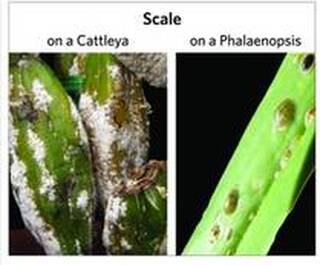
Scale are piercing, sucking insects that are difficult to control as the reproducing females are covered by a protective shell which also protects her eggs. Usually, only the mature insects are easily seen with the naked eye. Depending on the type of scale, adults are small and round and can appear at the base of or under leaves and/or on pseudoblubs, flowers, rhizomes or even roots in severe cases. Heavy infestation can cause plant decline and eventually kill the plant if not dealt with properly.
To remove scale, use a small toothbrush or cotton swab soaked in rubbing alcohol (known as isopropyl alcohol) to remove the pests. Do not use other forms of alcohol. Be sure to check and treat all affected areas of the plant – especially in the tight areas around the base of leaves. Check the plant again in a week for the presence of more pests as a follow-up treatment is often needed to fully rid the orchid of pests. For heavy infestations, a good systemic insecticide will be necessary. Always follow label directions when applying pesticides.
To remove scale, use a small toothbrush or cotton swab soaked in rubbing alcohol (known as isopropyl alcohol) to remove the pests. Do not use other forms of alcohol. Be sure to check and treat all affected areas of the plant – especially in the tight areas around the base of leaves. Check the plant again in a week for the presence of more pests as a follow-up treatment is often needed to fully rid the orchid of pests. For heavy infestations, a good systemic insecticide will be necessary. Always follow label directions when applying pesticides.
Eliminating Aphids
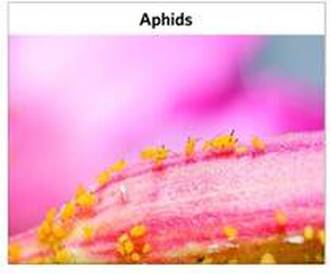
Aphids are small, soft-bodied insects that are generally pear-shaped and green or black in color. They reproduce rapidly and are
most often seen on flower buds/spikes and new growth. They produce honeydew which can encourage the growth of a black fungus known as sooty mold which is often a telltale sign of aphid infestation.
To remove aphids, use a small toothbrush or cotton swab soaked in rubbing alcohol (known as isopropyl alcohol) to remove the
pests. Do not use other forms of alcohol. Be sure to check and treat all affected areas of the plant – especially in the tight areas
around the base of leaves. Check the plant again in a week for the presence of more pests as a follow-up treatment is often needed to fully rid the orchid of pests. For heavy infestations, a good systemic insecticide will be necessary. Always follow label directions when applying pesticides.
most often seen on flower buds/spikes and new growth. They produce honeydew which can encourage the growth of a black fungus known as sooty mold which is often a telltale sign of aphid infestation.
To remove aphids, use a small toothbrush or cotton swab soaked in rubbing alcohol (known as isopropyl alcohol) to remove the
pests. Do not use other forms of alcohol. Be sure to check and treat all affected areas of the plant – especially in the tight areas
around the base of leaves. Check the plant again in a week for the presence of more pests as a follow-up treatment is often needed to fully rid the orchid of pests. For heavy infestations, a good systemic insecticide will be necessary. Always follow label directions when applying pesticides.
Treating Mealybugs
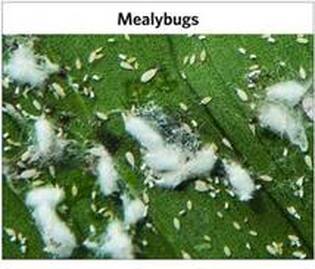
Sometimes confused with scale, mealybugs are a soft-bodied insect that are readily identified at the mature stage as white to
greyish-white and cotton-like. They are often found in the same areas as scale and can do substantial damage if not dealt with immediately.
To remove mealybugs, use a small toothbrush or cotton swab soaked in rubbing alcohol (known as isopropyl alcohol) to remove
the pests. Do not use other forms of alcohol. Be sure to check and treat all affected areas of the plant – especially in the tight areas around the base of leaves. Check the plant again in a week for the presence of more pests as a follow-up treatment is often needed to fully rid the orchid of pests. For heavy infestations, a good systemic insecticide will be necessary. Always follow label directions when applying pesticides.
greyish-white and cotton-like. They are often found in the same areas as scale and can do substantial damage if not dealt with immediately.
To remove mealybugs, use a small toothbrush or cotton swab soaked in rubbing alcohol (known as isopropyl alcohol) to remove
the pests. Do not use other forms of alcohol. Be sure to check and treat all affected areas of the plant – especially in the tight areas around the base of leaves. Check the plant again in a week for the presence of more pests as a follow-up treatment is often needed to fully rid the orchid of pests. For heavy infestations, a good systemic insecticide will be necessary. Always follow label directions when applying pesticides.
Thirsty Thrips
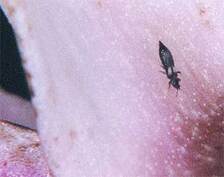
These are very small, elongated insects that are most prevalent on flowers and buds. Often, their presence is not recognized until the damage from their feeding is obvious. Their sucking of plant juices can cause deforming of buds, flowers, and new growth as well as browning on the margins of flowers. They can also cause pre-mature browning of buds and flower spikes. If damage by thrips is suspected, place a white sheet of paper under a flower or opening bud and tap on the bud/flower several times. If small yellow or black dots are seen moving around on the paper, thrips are present.
To get rid of thrips, purchase a pesticide. However, the plant should be inspected again every week and the procedure repeated until no infestation is visible. Two repeat applications at weekly intervals are necessary to control successive generations.
To get rid of thrips, purchase a pesticide. However, the plant should be inspected again every week and the procedure repeated until no infestation is visible. Two repeat applications at weekly intervals are necessary to control successive generations.
Beating Mighty Mites
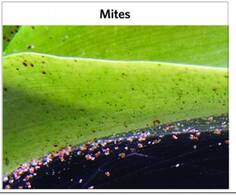
Mites are microscopic, and their presence is often not known until the damage is very evident. They often attack the undersides of leaves leaving areas that look slivery and pitted.
The most common mite affecting orchids is the red spider mite. Webbing on leaves with very tiny red specs moving about on the webbing is a sign of a heavy red spider mite infestation.
To get rid of mites, it is important to note that mites are not insects! So, most insecticides are not effective against mites. You must purchase a pesticide that is specifically labeled as a miticide for use against this pest. For small infestations in the home, wiping the infested areas with a cotton ball dipped in rubbing alcohol can be effective. However, the plant should be inspected again every week and the procedure repeated until no infestation is visible. If using a pesticide, two repeat applications at weekly intervals are necessary.
The most common mite affecting orchids is the red spider mite. Webbing on leaves with very tiny red specs moving about on the webbing is a sign of a heavy red spider mite infestation.
To get rid of mites, it is important to note that mites are not insects! So, most insecticides are not effective against mites. You must purchase a pesticide that is specifically labeled as a miticide for use against this pest. For small infestations in the home, wiping the infested areas with a cotton ball dipped in rubbing alcohol can be effective. However, the plant should be inspected again every week and the procedure repeated until no infestation is visible. If using a pesticide, two repeat applications at weekly intervals are necessary.
Greedy Grasshoppers
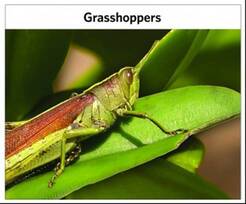
Grasshoppers, especially Lubbers, can do significant damage to your orchid in a very short period of time. Lubbers are usually 1” to 3” long and can vary in color from yellow to black depending on the Lubber species and stage of growth. These are best controlled immediately by hand, pruners or shoe/boot.
